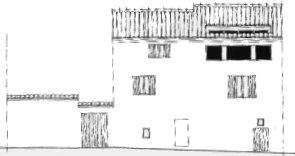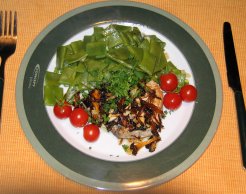
Les Colonnes
Saint Romain en Viennois

 |
Les ColonnesSaint Romain en Viennois |
 |
|
|||||
|
Beverly's Foodie Diary Christmas 2008 Une Semaine d'Excesse Thinking my French was up to the task, I pre-ordered a turkey for our Christmas dinner. In discussion with the butcher, I thought I made it clear I wanted it without stuffing as I would use 'la recette de ma Grandmere'. On arrival at the butcher shop I went into shock when handed a smallish package and was told it cost 110 euros (yes, nearly £100). I'm not good at reacting immediately and so handed over the credit card and went away with tears and anger. I thought I had ordered an ordinary turkey. Shortly thereafter I learned that the turkey - stuffing included - was a 'Dinde de Bresse', a limited edition, top quality bird raised in the area northeast of Lyon. Volailes de Bresse are molly-coddled, specific breeds of chickens and turkeys, carefully raised with their every whim catered to. Only a few are raised each year and the likes of Paul Bocuse buy them. Hence the high price. And yes, it was a dream turkey. It was so tender the knife almost went through the breast by its own weight. We unstuffed it, used our own stuffing, and made excellent meatballs with the original stuffing. The bird, about 4 kilos, served 4 adults, offered some leftovers and made a superb soup. It was fabulous but I'm not likely to do this every year! In fact this year we spent 10 euros on a great duck for 2 adults. This was the season when we finally got some of our local wild boar to cook. Andre said - 'meet me in the car park about 10 pm and I'll take you to ther person who has the boar'. It seemed a fine and mysterious lark. I wasn't really sure what to expect. My worst fear was a whole leg with hoof and fur. And yes, that was what came out of the freezer first. Andre continued the discussion for his own choice of meat while I struggled to think how I would get the hoof off and the meat in the pot. Eventually I summoned up the nerve to say this piece would not do and could we have something else. So we ended up with a superb loin cut. It was cooked in the Alsace manner with sauerkraut and was sweet and delicious. Andre would not go near it as 6 months in Alsace earlier in his life cured him of any desire for sauerkraut.
On our last day in the area, we were stuck in Orange having work done on our car. So I bought fresh ingredients in the market for ratatouille and brought them home to Glasgow. Now a little bit of Provence still exists in my freezer to comfort us on gloomy dreary nights. I am totally in love with the tomatoes. This time I tried a tomatoe tarte. The tomatoes are skinned and de-seeded, arranged on a crust and a bed of creme fraiche and mustard, dressed with herbs and olive oil and baked. Delicious!
Later in the winter I have my fingers crossed to access some wild boar from our local hunt club and make a stew at Christmas. We'll see if that works out! Summer 2006 - The Ratatouille Challenge! Michael, a good friend from Glasgow, came to stay with us for 2 weeks in June. He brought a set of ratatouille recipes with the intention of trying each to find the best and rapidly settled on a recipe by Jane Grigson. This calls for equal amounts of courgette, aubergine, green or red pepper and onions (500 grams of each). The courgette and aubergine are dusted in flour and sauteed. The pepper and onions are sauteed without flour. The sauce is carefully distilled and reduced from fresh tomatoes. With tender loving care, Michael made the first batch. It took 5 hours and was the best I ever tasted. But he tried again in order to shorten the time. In about 4 hours he had a fabulous ratatouille. In the second week he tried a third time and reached ratatouille nirvana. It was heavenly. So now we set out a challenge for aspiring cooks who come to visit: can you produce an equally divine ratatouille? Quintin came to visit in July and worked on a new recipe for ratatouille. He based it very loosely on a recipe by Sarah Leah Chase in her book 'Pedalling Through Provence'. Sarah suggests roasting the vegetables first in order to deepen flavour. She also has the temerity to suggest adding other vegs like potatoe and asparagus. It's quite a shock but Quintin went for it. He roasted potatoes, aubergines, peppers, courgettes and onions. Delia Smith also recommends roasting the vegs so there was a good precedent. But, while neither Sarah nor Delia's recipes called for a true tomato sauce, Quintin decided to add that to the recipe. He cooked down a sauce of fresh tomatoes, the roasted onions and roasted garlic. A small splash of Cotes du Rhone 'La Nyonsaise' was added along with fresh basil. The whole was mixed together and put in the oven for a final blending of the flavours. Thank heaven our heatwave broke in this afternoon and everywhere became much cooler - down to 26 degrees Celsius. The oven heated the kitchen a bit but it was tolerable with the cooler temperatures all around. In the end, he produced an interesting and varied ratatouille. We agreed that the potatoes, while delicious when roasted and before being mixed in with the other vegs, were not a truly beneficial addition to the pot. The texture was too great a contrast. But apart from the spuds, it was a delicious dish. Additional ratatouilles were produced by David and later by Muffy. Both were hard-pressed to give it long, loving attention. When caught up in the holiday tasks of locating eagles, running up, down and around mountains, socialising with the neighbours, visiting Roman monuments, it's hard to devote time to cooking. But both produced delicious ratatouilles, one with the seasonal addition of cepes. For my own part, I found some decaying courgettes in the fridge and needed to do a rescue job. I was trying to work slowly and carefully but, in time honoured fashion, I managed to scorch the courgettes and onions. My tomato sauce was good but meagre, with only one large Russian tomato to use, so I threw in some ready-made tomato sauce. This saved the day, making the ratatouille edible but certainly not a prize-winner. By end of season, between us all we have used a good number of the local courgettes, aubergines, peppers, onions, tomatoes, garlic and basil. We've enjoyed a variety of recipes and were able to compare a lot of ideas. I've decided that recipes using weights of produce are easier to get right than those saying things like 'take one aubergine.' How big should it be? How can I tell how much is enough? We've had long discussions on the texture of ratatouille, the best ratio of vegetables to use, what secret or magic ingredients to add. We've raised an important question of 'when is a ratatouille not a ratatouille'? This would go for any regional special dish. For example, can we put sausage in bouillabaisse? Fish in cassoulet? How far can one go with a traditional recipe, adapting it for modern ingredients or needs but still able to call it by its original name? When Harry poured champagne freely into the paella, did it change the dish or just make a superb Paella Royale?
Winter 2005-2006 Through the winter, cooking was a huge challenge. The electrician kept reducing the amount of electricity available as he cut off circuits and rooms. The winter was one of the coldest in years. The house was wide open upstairs. The amount of mud and dust from the construction work was unbelievable. The tale of Christmas dinner follow below. By late January I was finally forced to eat out as no cooking could be done at all.
September 2005 Our village is close to Vaison-la-Romaine which has had an open-air market every Tuesday since it was first established by Papal Decree in 1592. Every week the streets fill with vendors of every kind of food, lush plants, new and used clothing, tools, soaps, dishes, tablecloths, linens and every imaginable item in between. The food stalls vary with the season, although vendors keep the same pitches, so that once you know the streets and locations you can always find and get to know your favourite specialists in fish, sausages, truffles, mushrooms, cheese and vegetables. One of the great pleasures for a new arrival is getting to know this market and the other smaller but similar ones in the other villages.
I was also keen to find a way to exploit this mushroom bonanza along with fish, one of my favourite foods. I couldn't think of any recipes or menus that combined fish and mushrooms, so I asked the fishmonger at our local supermarket for advice. She suggested a fresh white tuna steak and girolles. I seared the tuna in olive oil and then sweated the girolles with some garlic. I put the tuna on a warm plate and piled the girolles and fresh parsley on top. You can see the result at the top of this page, served with boiled flat green beans and topped with sweet fresh cherry tomatoes from our garden.
|
|||||
Last update: 20 May, 2014